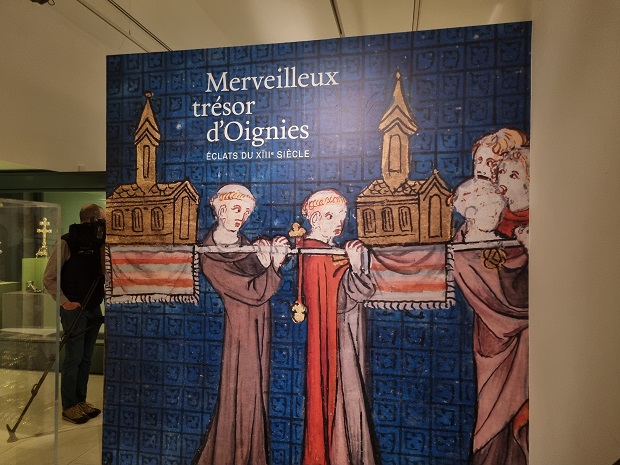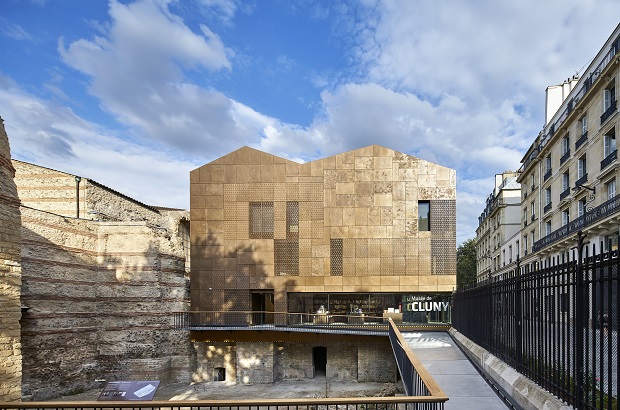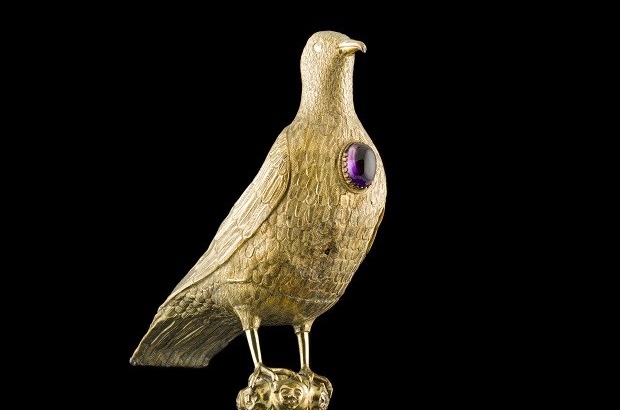- Daily & Weekly newsletters
- Buy & download The Bulletin
- Comment on our articles
The treasure of Oignies: 13th-century Belgian gold and silver collection shines in Paris
One of the seven marvels of Belgium – an extraordinary and rare medieval collection of gold and silver - is on show at France’s national museum dedicated to the Middle Ages in Paris.
The Wonderful Treasure of Oignies: 13th Century Sparks of Brilliance is displayed at Musée de Cluny until 20 October. The exhibition shines a light on one of Belgium’s little-known heritage jewels and the remarkable story of how it survived virtually intact over hundreds of sometimes turbulent years.
Originating from the priory of Oignies on the banks of the Sambre river in Wallonia, it is also testament to its creator Hugo, a virtuoso goldsmith whose workshop fashioned reliquaries and other religious objects from an array of precious metals and materials in the 13th century. With its modern and illuminating scenography, the Paris exhibition also opens a window on religious life in the Middle Ages.

The treasure now belongs to the King Baudouin Foundation, Belgium’s leading philanthropy organisation. It was donated by the Sisters of Notre-Dame of Namur in 2010 and its permanent home remains in the Walloon capital’s Musée Provincial des Arts Anciens (TreM.a).
When the museum had to close for renovation work, the director of the provincial cultural heritage department Julien De Vos called the Cluny museum to discuss a potential collaboration. It was the beginning of a new adventure for the treasure, travelling for the first time beyond Belgium’s border, in custom-made boxes and transported by road with a special security detail.
For De Vos, passionate co-curator of the Paris exhibition alongside Cluny’s head curator Christine Descatoire, it represented an intensely satisfying challenge to share the collection with a wider world and see the familiar works presented in a new light.
Illuminating exhibition
While the exceptional and coherent collection comprises 50 pieces in total, 35 of the finest examples are exhibited in Paris. Benefitting from the museum’s expertise in lighting, they are presented in 3D display cases that offer a panoramic view for visitors. The treasures literally dazzle under their new illumination. While the objects take centre stage, explanatory panels line the walls to provide context.

The first cabinet contains a chalice (pictured above) and paten, attributed to priory founder Gilles de Walcourt, and stunning Evangeliary bookbinding plates. All three works are signed by Hugo d’Oignies, the younger brother of Gilles.
The plates are a glorious display of the craftsman’s artistry and skill. He mastered multiple techniques and adhered to iconographic religious traditions while introducing innovative natural elements such as foliage motifs with his trademark touch of spontaneity. Each plate (pictured below) in embossed and finely chiselled silver is embellished with Hugo’s preferred style of niello inlay (a black compound that fills indentations), delicate filigree and incrusted stones, cameos and gems.

Reliquaries represent a major part of the collection and the exhibits on show. They served as ornate containers to house relics, often fragments of tortured saints and other sacred objects, which drew pilgrims from near and far.
Some of the more spectacular examples include “speaking” reliquaries, which denotes relics contained in an object made in the form of its body part, such as the astonishing reliquary feet of Saint Blaise and Saint James.

A highly singular work is the reliquary of the Virgin’s Milk that takes the form of a golden dove (pictured above), adorned on its breast with a large amethyst. It’s a unique and highly decorative work with delicately chiselled wings and feathers.
Other elements of the treasure include a Byzantine cross and triptych used by the priory’s benefactor, the ecclesiastic dignitary Jacques de Vitry. One of the few lay objects in the collection is a highly decorative goblet believed to have belonged to Marie d’Oignies, an influential member of the religious community.
Influential and inspirational figures
The Augustinian priory, founded in 1192, owed its spiritual and material wealth to its rich collection of cult objects. Integral to Hugo’s work was the contribution by these two individuals. The arrival of Marie de Nivelles, later sanctified and known as d’Oignies, was to prove decisive as she combined mystical qualities with a strong personality and served as Hugo’s muse. She was also an instigator of beguines, the women’s communities that would spring up around the country. Completing this triangle was de Vitry. More than a wealthy patron, he was an enigmatic figure whose prominent position in the church - he was once Bishop of Acre in the Holy Land - enabled him to donate the all-important relics and precious stones and objects to the priory. From gems, pearls and ivory to Byzantine enamel and Egyptian glass, they were gleaned during his many travels in the Orient. Such trade prospered during the early 1200s due to the crusades.

Originally from France, de Vitry was very attached to the Belgian monastery and to Marie. His writings about her are a significant record of this period. When he died in 1240, his body was brought back to the Namur region and buried alongside Marie who had passed away in 2013.
Without the inspiration and philanthropy of these two figures, Hugo and his workshop would not have achieved such transcendent work. While continuing the established local tradition of Mosan silverware, his workshop proved to be highly influential beyond his death around 1240.
History of the treasure
Although many other treasures from the region disappeared, by fortune and careful stewardship, the Oignies collection survived. It’s another colourful chapter in the treasure’s history. Some pieces were sold by monks – they now belong to the Museum of History and Art in Brussels – but the collection remained largely intact. This was despite various periods of conflict. It was during the Austrian regime that Oignies’ last prior had the treasure walled up in a nearby farm in 1794. It remained there for 24 years until the property was sold.
The treasure was then entrusted to the mother superior of Notre-Dame of Namur, where it was devotedly looked after for almost 200 years. The convent lent a few objects to an exhibition in Mechelen in 1864, but otherwise it remained intact. Fearful of the German army’s impending occupation, the nuns had the foresight to remove the treasure from the convent in 1939, which suffered bombardment in 1940. The treasure remained hidden until it returned to the convent in 1952. Thereafter, it occupied cabinets in a rather gloomy room with the nuns showing it off to visitors who dared knock on their door.

De Vos is effusive in his praise for the nuns’ recognition of its value. “It wasn’t their mission, but they played a real role in its transmission and that is commendable,” he says. When the collection returns to Namur after its Paris experience, a new curator will take over De Vos’s current responsibility. “I’m quite emotional,” he admits. “It’s rare in the world today to succeed such a challenge as conserving these extremely fragile and delicate objects.”
He equally applauds the KBF in accepting the donation by the convent and providing support for the Paris exhibition. As part of its Heritage & Culture Programme, the foundation has a mission to promote such collections and make them accessible to the general public.
The Cluny museum (pictured below) in the heart of the Latin quarter of Paris is the national reference for the Middle Ages. Among its many permanent masterpieces is the Lady and the Unicorn series of exquisite medieval tapestries that were woven in Flanders. Now they are joined - temporarily at least - by an often overlooked yet remarkable treasure trove of a collection that is intrinsic to the history of the Middle Ages in Belgium.

Seven wonders
The Oignies treasure was proclaimed as one of the Seven Wonders of Belgium in 1978. This rather overlooked heritage list comprises medieval and Flemish Renaissance masterpieces. Inspired by the famous wonders of the ancient world, it was created by Arthur Haulot, a former general commissioner for tourism. As a survivor of wartime concentration camps, he had a deep conviction that conflict could be avoided by an increased understanding of other cultures.
The wonders were selected from seven major cities: three from Flanders, three from Wallonia and one from the capital. As well as the Oignies treasure, it includes the following works: the Ghent Altarpiece (the Mystic Lamb); the baptismal font of Saint-Barthélémy church in Liège; the shrine of Notre-Dame cathedral in Tournai; Bruegel’s Fall of Icarus painting at the Museum of Fine Arts in Brussels; Rubens’ Descent from the Cross in Antwerp’s Cathedral of Our Lady; and the Shrine of Saint Ursula of Memling in Bruges.
The Wonderful Treasure of Oignies: 13th Century Sparks of Brilliance
Musée de Cluny
Until 20 October
Rue Du Sommerard 28
Paris
Photos: ©King Baudouin Foundation/Namur Musée provincial des arts anciens; Musée de Cluny © M. Denancé



















